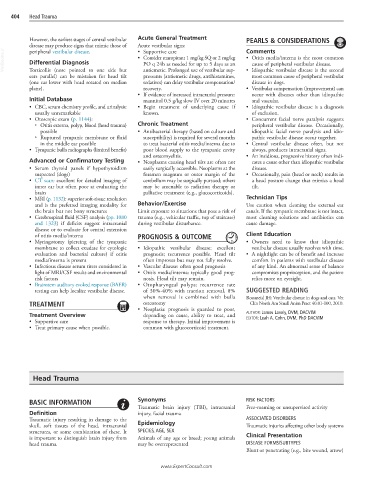Page 843 - Cote clinical veterinary advisor dogs and cats 4th
P. 843
404 Head Trauma
However, the earliest stages of central vestibular Acute General Treatment PEARLS & CONSIDERATIONS
disease may produce signs that mimic those of Acute vestibular signs: Comments
VetBooks.ir Differential Diagnosis • Consider maropitant 1 mg/kg SQ or 2 mg/kg • Otitis media/interna is the most common
• Supportive care
peripheral vestibular disease.
PO q 24h as needed for up to 5 days as an
cause of peripheral vestibular disease.
Torticollis (nose pointed to one side but
most common cause of peripheral vestibular
pressants (antiemetic drugs, antihistamines,
ears parallel) can be mistaken for head tilt antiemetic. Prolonged use of vestibular sup- • Idiopathic vestibular disease is the second
(one ear lower with head rotated on median sedatives) can delay vestibular compensation/ disease in dogs.
plane). recovery. • Vestibular compensation (improvement) can
• If evidence of increased intracranial pressure: occur with diseases other than idiopathic
Initial Database mannitol 0.5 g/kg slow IV over 20 minutes and vascular.
• CBC, serum chemistry profile, and urinalysis: • Begin treatment of underlying cause if • Idiopathic vestibular disease is a diagnosis
usually unremarkable known. of exclusion.
• Otoscopic exam (p. 1144): • Concurrent facial nerve paralysis suggests
○ Otitis externa, polyp, blood (head trauma) Chronic Treatment peripheral vestibular disease. Occasionally,
possible • Antibacterial therapy (based on culture and idiopathic facial nerve paralysis and idio-
○ Ruptured tympanic membrane or fluid susceptibility) is required for several months pathic vestibular disease occur together.
in the middle ear possible to treat bacterial otitis media/interna due to • Central vestibular disease often, but not
• Tympanic bulla radiographs (limited benefit) poor blood supply to the tympanic cavity always, produces intracranial signs.
and osteomyelitis. • An insidious, progressive history often indi-
Advanced or Confirmatory Testing • Neoplasms causing head tilts are often not cates a cause other than idiopathic vestibular
• Serum thyroid panels if hypothyroidism easily surgically accessible. Neoplasms at the disease.
suspected (dogs) foramen magnum or outer margin of the • Occasionally, pain (head or neck) results in
• CT scan: excellent for detailed imaging of cerebellum may be surgically pursued; others a head posture change that mimics a head
inner ear but often poor at evaluating the may be amenable to radiation therapy or tilt.
brain palliative treatment (e.g., glucocorticoids).
• MRI (p. 1132): superior soft-tissue resolution Technician Tips
and is the preferred imaging modality for Behavior/Exercise Use caution when cleaning the external ear
the brain but not bony structures Limit exposure to situations that pose a risk of canals. If the tympanic membrane is not intact,
• Cerebrospinal fluid (CSF) analysis (pp. 1080 trauma (e.g., vehicular traffic, top of staircase) most cleaning solutions and antibiotics can
and 1323) if deficits suggest intracranial during vestibular disturbance. cause damage.
disease or to evaluate for central extension
of otitis media/interna PROGNOSIS & OUTCOME Client Education
• Myringotomy (piercing of the tympanic • Owners need to know that idiopathic
membrane to collect exudate for cytologic • Idiopathic vestibular disease: excellent vestibular disease usually resolves with time.
evaluation and bacterial culture) if otitis prognosis; recurrence possible. Head tilt • A nightlight can be of benefit and increase
media/interna is present often improves but may not fully resolve. comfort in patients with vestibular disease
• Infectious disease serum titers considered in • Vascular disease: often good prognosis of any kind. An abnormal sense of balance
light of MRI/CSF results and environmental • Otitis media/interna: typically good prog- compromises proprioception, and the patient
risk factors nosis. Head tilt may remain. relies more on eyesight.
• Brainstem auditory evoked response (BAER) • Otopharyngeal polyps: recurrence rate
testing can help localize vestibular disease. of 30%-40% with traction removal, 8% SUGGESTED READING
when removal is combined with bulla Rossmeisl JH: Vestibular disease in dogs and cats. Vet
TREATMENT osteotomy Clin North Am Small Anim Pract 40:81-100, 2010.
• Neoplasia: prognosis is guarded to poor,
Treatment Overview depending on cause, ability to treat, and AUTHOR: James Lavely, DVM, DACVIM
• Supportive care response to therapy. Initial improvement is EDITOR: Leah A. Cohn, DVM, PhD DACVIM
• Treat primary cause when possible. common with glucocorticoid treatment.
Head Trauma
BASIC INFORMATION Synonyms RISK FACTORS
Traumatic brain injury (TBI), intracranial Free-roaming or unsupervised activity
Definition injury, facial trauma
Traumatic injury resulting in damage to the Epidemiology ASSOCIATED DISORDERS
skull, soft tissues of the head, intracranial Traumatic injuries affecting other body systems
structures, or some combination of these. It SPECIES, AGE, SEX Clinical Presentation
is important to distinguish brain injury from Animals of any age or breed; young animals
head trauma. may be overrepresented DISEASE FORMS/SUBTYPES
Blunt or penetrating (e.g., bite wound, arrow)
www.ExpertConsult.com

